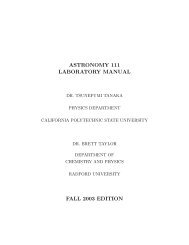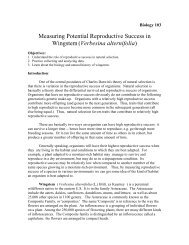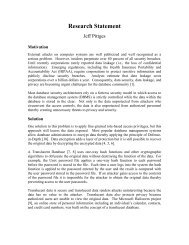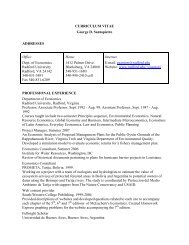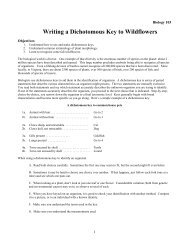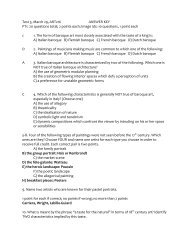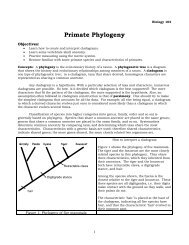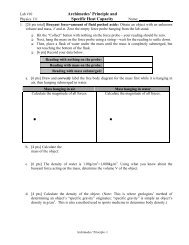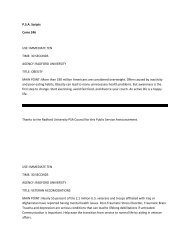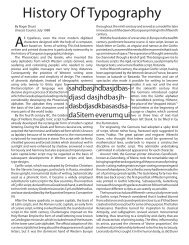A.6 Phases of the Moon
A.6 Phases of the Moon
A.6 Phases of the Moon
Create successful ePaper yourself
Turn your PDF publications into a flip-book with our unique Google optimized e-Paper software.
CHAPTER A. LABORATORY EXPERIMENTS 35<br />
Name: Section: Date:<br />
<strong>A.6</strong> <strong>Phases</strong> <strong>of</strong> <strong>the</strong> <strong>Moon</strong><br />
I. Introduction<br />
Earth has only one natural satellite, <strong>the</strong> <strong>Moon</strong>. It is <strong>the</strong> one <strong>of</strong> <strong>the</strong> largest satellites in <strong>the</strong> solar system. It<br />
takes <strong>the</strong> <strong>Moon</strong> 29.5 days to orbit around <strong>the</strong> Earth, and it always shows <strong>the</strong> same side towards <strong>the</strong> Earth.<br />
In this activity we are going to study <strong>the</strong> most noticeable feature <strong>of</strong> <strong>the</strong> <strong>Moon</strong>, <strong>the</strong> phase. The phase <strong>of</strong> <strong>the</strong><br />
<strong>Moon</strong> is a result <strong>of</strong> <strong>the</strong> relative angles between <strong>the</strong> <strong>Moon</strong>, Earth, and Sun.<br />
First Quarter<br />
Full <strong>Moon</strong><br />
12 midnight<br />
180°<br />
Earth<br />
12 noon<br />
To <strong>the</strong> Sun<br />
0°<br />
New <strong>Moon</strong><br />
Sunlight<br />
Third Quarter<br />
Figure A.15: The phase <strong>of</strong> <strong>the</strong> <strong>Moon</strong> seen from <strong>the</strong> Earth depends on <strong>the</strong> relative positions <strong>of</strong> <strong>the</strong> Sun,<br />
Earth, and <strong>Moon</strong>.<br />
II. Reference<br />
• 21 st Century Astronomy, Chapter 2, pp. 43 – 46.<br />
III. Materials Used<br />
• ball<br />
• light bulb
36 CHAPTER A. LABORATORY EXPERIMENTS<br />
IV. Activities<br />
Lunar <strong>Phases</strong><br />
1 Turn on <strong>the</strong> light bulb. We are going to pretend <strong>the</strong> bulb is <strong>the</strong> Sun. Hold a ball at arm’s length.<br />
Which side <strong>of</strong> <strong>the</strong> ball is illuminated? Which side is in shadow?<br />
2 In Fig. A.15, shade <strong>the</strong> dark sides <strong>of</strong> <strong>the</strong> <strong>Moon</strong> and <strong>the</strong> Earth. The side facing away from <strong>the</strong> Sun is<br />
always in <strong>the</strong> dark.<br />
3 We are going to measure all angles from <strong>the</strong> direction <strong>of</strong> <strong>the</strong> Sun (0 ◦ ) in <strong>the</strong> counterclockwise direction.<br />
Find <strong>the</strong> angle to <strong>the</strong> <strong>Moon</strong> at each location on <strong>the</strong> orbit.<br />
4 Pretend your head is <strong>the</strong> Earth. The ball is going to represent <strong>the</strong> <strong>Moon</strong>. Hold <strong>the</strong> ball in your hand<br />
and stretch your arm. As you spin counterclockwise, <strong>the</strong> <strong>Moon</strong> orbits around you. Notice that <strong>the</strong><br />
<strong>Moon</strong> is illuminated by <strong>the</strong> Sun from different angles with respect to <strong>the</strong> Earth. At 0 ◦ , your head, <strong>the</strong><br />
ball, and <strong>the</strong> bulb are aligned in a straight line. You can see only <strong>the</strong> dark side <strong>of</strong> <strong>the</strong> <strong>Moon</strong>. It is <strong>the</strong><br />
new moon.<br />
5 Now rotate counterclockwise by 45 ◦ . You should be able to see a crescent moon. Sketch <strong>the</strong> phase and<br />
label <strong>the</strong> phase. Keep rotating by 45 ◦ , and for each angle, sketch and label <strong>the</strong> phase.<br />
New <strong>Moon</strong><br />
0°<br />
Full <strong>Moon</strong><br />
45° 90° 135°<br />
180°<br />
225° 270° 315°<br />
Figure A.16: Lunar phases and corresponding angles between <strong>the</strong> Sun and <strong>Moon</strong>.<br />
What time does a full moon rise?<br />
We can use Fig. A.15 to find what time <strong>the</strong> <strong>Moon</strong> <strong>of</strong> a particular phase rises or sets. Also, we can find <strong>the</strong><br />
time <strong>of</strong> <strong>the</strong> transit. The transit is <strong>the</strong> time when <strong>the</strong> <strong>Moon</strong>, or any celestial body, is exactly on <strong>the</strong> local<br />
celestial meridian (LCM).<br />
1 The local time is defined by <strong>the</strong> position <strong>of</strong> <strong>the</strong> Sun in <strong>the</strong> sky. When <strong>the</strong> Sun is on <strong>the</strong> LCM, it is <strong>the</strong><br />
local noon. From Fig. A.15, find <strong>the</strong> local time for <strong>the</strong> transit for each lunar phase.
CHAPTER A. LABORATORY EXPERIMENTS 37<br />
Table A.15: The transit depends on <strong>the</strong> phase <strong>of</strong> <strong>the</strong> <strong>Moon</strong>.<br />
lunar phase rise transit set<br />
new moon<br />
first quarter<br />
12:00 noon<br />
full moon<br />
12:00 midnight<br />
third quarter<br />
2 The <strong>Moon</strong> rises 6 hours before <strong>the</strong> transit and sets 6 hours after <strong>the</strong> transit. Find when each lunar<br />
phase rises and sets.<br />
V. Questions<br />
1. What is <strong>the</strong> phase <strong>of</strong> <strong>the</strong> <strong>Moon</strong> if <strong>the</strong> angle between <strong>the</strong> Sun and <strong>Moon</strong> is 150 ◦ in <strong>the</strong> counterclockwise<br />
direction?<br />
2. What is <strong>the</strong> phase <strong>of</strong> <strong>the</strong> <strong>Moon</strong> during a solar eclipse?<br />
3. Your younger bro<strong>the</strong>r swears that he saw a crescent moon at midnight. Can you trust him? Explain<br />
your reasoning.<br />
VI. Credit<br />
To obtain credit for this lab, you need to turn in appropriate tables <strong>of</strong> data, observations, calculations,<br />
graphs, and a conclusion as well as <strong>the</strong> answers to <strong>the</strong> above questions. Do not forget to label axes and give<br />
a title to each graph. Show your work in calculations. A final answer in itself is not sufficient. Don’t leave<br />
out units. In <strong>the</strong> conclusion part, briefly summarize what you have learned in <strong>the</strong> lab and possible sources<br />
<strong>of</strong> error in your measurements and how <strong>the</strong>y could have affected <strong>the</strong> final result. (No, you cannot just say



